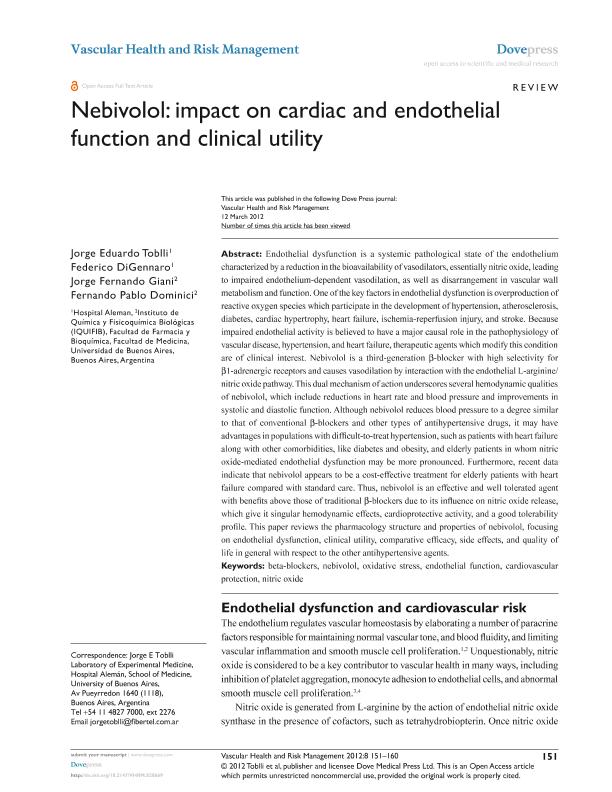Mostrar el registro sencillo del ítem
dc.contributor.author
Toblli, Jorge Eduardo

dc.contributor.author
DiGennaro, Federico

dc.contributor.author
Giani, Jorge Fernando

dc.contributor.author
Dominici, Fernando Pablo

dc.date.available
2017-06-15T15:17:19Z
dc.date.issued
2012-03
dc.identifier.citation
Toblli, Jorge Eduardo; DiGennaro, Federico; Giani, Jorge Fernando; Dominici, Fernando Pablo; Nebivolol: impact on cardiac and endothelial function and clinical utility; Dove Medical Press; Vascular Health and Risk Management; 2012; 8; 3-2012; 151-160
dc.identifier.issn
1176-6344
dc.identifier.uri
http://hdl.handle.net/11336/18236
dc.description.abstract
Endothelial dysfunction is a systemic pathological state of the endothelium characterized by a reduction in the bioavailability of vasodilators, essentially nitric oxide, leading to impaired endothelium-dependent vasodilation, as well as disarrangement in vascular wall metabolism and function. One of the key factors in endothelial dysfunction is overproduction of reactive oxygen species which participate in the development of hypertension, atherosclerosis, diabetes, cardiac hypertrophy, heart failure, ischemia-reperfusion injury, and stroke. Because impaired endothelial activity is believed to have a major causal role in the pathophysiology of vascular disease, hypertension, and heart failure, therapeutic agents which modify this condition are of clinical interest. Nebivolol is a third-generation β-blocker with high selectivity for β1-adrenergic receptors and causes vasodilation by interaction with the endothelial L-arginine/nitric oxide pathway. This dual mechanism of action underscores several hemodynamic qualities of nebivolol, which include reductions in heart rate and blood pressure and improvements in systolic and diastolic function. Although nebivolol reduces blood pressure to a degree similar to that of conventional β-blockers and other types of antihypertensive drugs, it may have advantages in populations with difficult-to-treat hypertension, such as patients with heart failure along with other comorbidities, like diabetes and obesity, and elderly patients in whom nitric oxide-mediated endothelial dysfunction may be more pronounced. Furthermore, recent data indicate that nebivolol appears to be a cost-effective treatment for elderly patients with heart failure compared with standard care. Thus, nebivolol is an effective and well tolerated agent with benefits above those of traditional β-blockers due to its influence on nitric oxide release, which give it singular hemodynamic effects, cardioprotective activity, and a good tolerability profile. This paper reviews the pharmacology structure and properties of nebivolol, focusing on endothelial dysfunction, clinical utility, comparative efficacy, side effects, and quality of life in general with respect to the other antihypertensive agents.
dc.format
application/pdf
dc.language.iso
eng
dc.publisher
Dove Medical Press
dc.rights
info:eu-repo/semantics/openAccess
dc.rights.uri
https://creativecommons.org/licenses/by-nc/2.5/ar/
dc.subject
Beta-Blockers
dc.subject
Nebivolol
dc.subject
Oxidative Stress
dc.subject
Cardiovascular Protection
dc.subject
Endothelial Function
dc.subject
Nitric Oxide
dc.subject.classification
Ciencias y Servicios de Cuidado de la Salud

dc.subject.classification
Ciencias de la Salud

dc.subject.classification
CIENCIAS MÉDICAS Y DE LA SALUD

dc.title
Nebivolol: impact on cardiac and endothelial function and clinical utility
dc.type
info:eu-repo/semantics/article
dc.type
info:ar-repo/semantics/artículo
dc.type
info:eu-repo/semantics/publishedVersion
dc.date.updated
2017-06-14T18:55:28Z
dc.identifier.eissn
1178-2048
dc.journal.volume
2012
dc.journal.number
8
dc.journal.pagination
151-160
dc.journal.pais
Reino Unido

dc.journal.ciudad
Londres
dc.description.fil
Fil: Toblli, Jorge Eduardo. Consejo Nacional de Investigaciones Científicas y Técnicas; Argentina. Hospital Alemán. Laboratorio de Medicina Experimental; Argentina
dc.description.fil
Fil: DiGennaro, Federico. Hospital Alemán; Argentina
dc.description.fil
Fil: Giani, Jorge Fernando. Consejo Nacional de Investigaciones Científicas y Técnicas. Oficina de Coordinación Administrativa Houssay. Instituto de Química y Físico-Química Biológicas "Prof. Alejandro C. Paladini". Universidad de Buenos Aires. Facultad de Farmacia y Bioquímica. Instituto de Química y Físico-Química Biológicas; Argentina
dc.description.fil
Fil: Dominici, Fernando Pablo. Consejo Nacional de Investigaciones Científicas y Técnicas. Oficina de Coordinación Administrativa Houssay. Instituto de Química y Físico-Química Biológicas "Prof. Alejandro C. Paladini". Universidad de Buenos Aires. Facultad de Farmacia y Bioquímica. Instituto de Química y Físico-Química Biológicas; Argentina
dc.journal.title
Vascular Health and Risk Management
dc.relation.alternativeid
info:eu-repo/semantics/altIdentifier/doi/http://dx.doi.org/10.2147/VHRM.S20669
dc.relation.alternativeid
info:eu-repo/semantics/altIdentifier/url/https://www.dovepress.com/nebivolol-impact-on-cardiac-and-endothelial-function-and-clinical-util-peer-reviewed-article-VHRM
dc.relation.alternativeid
info:eu-repo/semantics/altIdentifier/url/https://www.ncbi.nlm.nih.gov/pmc/articles/PMC3310359/
Archivos asociados
